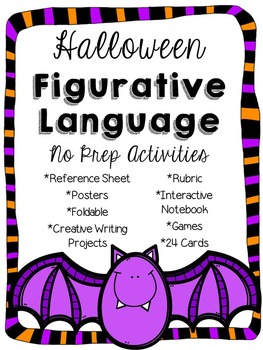Figurative Language Halloween Activities and Creative Writing Pack
Shannon Maree Teaching
2.5k Followers
Grade Levels
3rd - 7th
Resource Type
Standards
CCSSRL.3.5
CCSSRL.4.5
CCSSW.3.3
CCSSW.3.4
CCSSW.3.5
Formats Included
- PDF
Pages
35 pages
Shannon Maree Teaching
2.5k Followers
What educators are saying
This was my favorite resource to use last week. I was able to tailor each one to a day a piece in my lessons. My students fully understand each type of figurative language now.
Description
Looking for a great way to incorporate Halloween this fall but not lose any valuable teaching time? Using this NO PREP resource students learn figurative language in a fun and engaging way. Perfect for writing lessons during October!
The creative figurative language writing projects and rubric provide you with assessments and you can easily use the interactive notebooks, sorts, and games in centers, small groups, and partner or independent work!
Resource Includes:
-Student Reference Sheet
-6 Posters (can be used as anchor charts)
-24 Figurative Language Example Cards (6 examples of each element)
-Interactive Notebooking
-Foldable
-Creative 9 Writing Projects & Rubric
-Games: Halloween Hocus Pocus, Trashketball, Memory, and Sorting (OR pair with any game you already have in your room!)
Figurative Language Elements Included:
-Simile
-Metaphor
-Personification
-Alliteration
-Hyperbole
-Onomatopoeia
Don’t miss this NO PREP Halloween Math Packet!
The creative figurative language writing projects and rubric provide you with assessments and you can easily use the interactive notebooks, sorts, and games in centers, small groups, and partner or independent work!
Resource Includes:
-Student Reference Sheet
-6 Posters (can be used as anchor charts)
-24 Figurative Language Example Cards (6 examples of each element)
-Interactive Notebooking
-Foldable
-Creative 9 Writing Projects & Rubric
-Games: Halloween Hocus Pocus, Trashketball, Memory, and Sorting (OR pair with any game you already have in your room!)
Figurative Language Elements Included:
-Simile
-Metaphor
-Personification
-Alliteration
-Hyperbole
-Onomatopoeia
Don’t miss this NO PREP Halloween Math Packet!
Total Pages
35 pages
Answer Key
N/A
Teaching Duration
1 Week
Report this resource to TPT
Reported resources will be reviewed by our team. Report this resource to let us know if this resource violates TPT’s content guidelines.
Standards
to see state-specific standards (only available in the US).
CCSSRL.3.5
Refer to parts of stories, dramas, and poems when writing or speaking about a text, using terms such as chapter, scene, and stanza; describe how each successive part builds on earlier sections.
CCSSRL.4.5
Explain major differences between poems, drama, and prose, and refer to the structural elements of poems (e.g., verse, rhythm, meter) and drama (e.g., casts of characters, settings, descriptions, dialogue, stage directions) when writing or speaking about a text.
CCSSW.3.3
Write narratives to develop real or imagined experiences or events using effective technique, descriptive details, and clear event sequences.
CCSSW.3.4
With guidance and support from adults, produce writing in which the development and organization are appropriate to task and purpose.
CCSSW.3.5
With guidance and support from peers and adults, develop and strengthen writing as needed by planning, revising, and editing.





